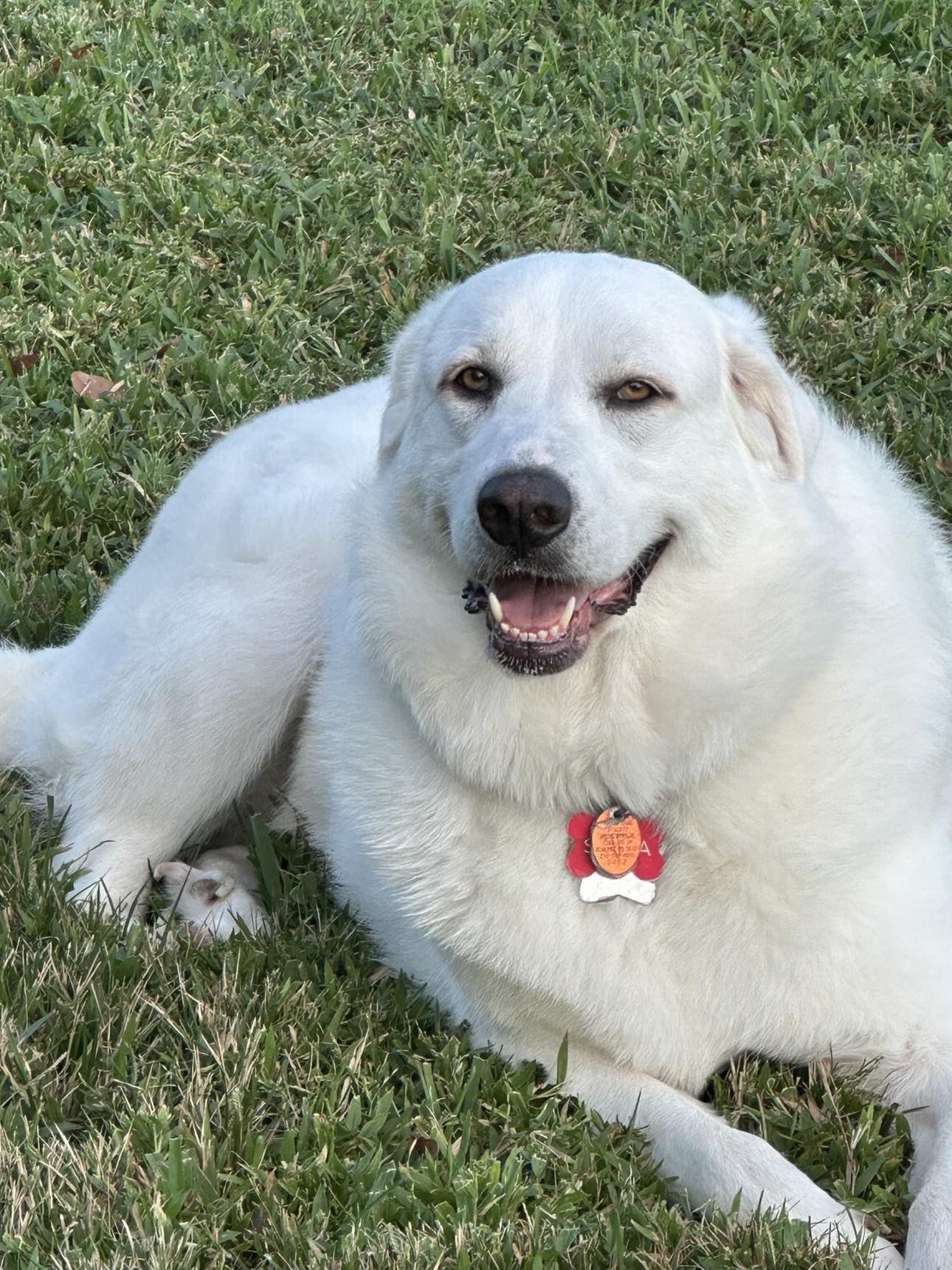Recently, during Sasha’s annual checkup, our conversation with Dr. Reyes, who is not only our trusted vet but also a fellow Great Pyrenees owner, turned toward a topic that caught my husband off guard – Gastric Dilatation-Volvulus (GDV), commonly known as bloat. While I had some knowledge about this serious condition, it was new to him. This concern was further heightened when I read about a two-year-old dog named Teddy Bear in a Great Pyrenees Facebook group. Teddy Bear nearly lost his life to bloat, with his condition escalating rapidly within just two hours, emergency surgery was crucial in saving his life. It made me realize that many other dog owners might also be unfamiliar with this life-threatening issue. How many of us are truly aware of the signs and preventive measures of bloat? Prompted by this, I decided to delve deeper into this topic. In this article, we will explore the causes, symptoms, treatments, and importantly, how we can prevent bloat in our beloved canine companions.
What is Bloat in Dogs?
Bloat, or Gastric Dilatation-Volvulus (GDV), is a critical and fast-progressing condition in dogs where the stomach excessively fills with gas, fluid, or food, leading to its expansion. This situation can escalate when the stomach twists on itself, a condition known as volvulus. The twisting of the stomach is particularly dangerous as it cuts off the blood supply to the stomach and occasionally to the spleen. This impedes the normal flow of blood and other fluids, leading to a rapid and significant decline in the dog’s health. Immediate medical attention is essential in such cases to prevent life-threatening complications.
Signs and Symptoms of Bloat
Recognizing the signs of bloat is critical for timely intervention. Key symptoms include:
- Excessive drooling
- A swollen or hard abdomen
- Restlessness and discomfort
- Attempts to vomit without producing anything.
- Rapid heartbeat and difficulty breathing
Key Risk Factors and Breed Susceptibility to Canine Bloat (GDV)
Certain breeds of dogs are more susceptible to bloat due to a combination of genetic, physical, and behavioral factors. This includes large breeds with deep chests, such as Great Danes, Saint Bernards, Weimaraner’s, Setters, and notably, the Great Pyrenees. Here are the reasons these breeds are at a higher risk:
- Chest Structure: Deep, narrow chests in these breeds may increase the likelihood of the stomach twisting.
- Genetic Predisposition: A hereditary component is often indicated, especially in dogs with a family history of GDV.
- Size and Age: Larger and older dogs face a higher risk as their stomach-supporting ligaments can weaken or stretch, making the stomach more prone to twisting.
- Temperament Factors: Dogs prone to anxiety or stress may have altered eating habits and gastric motility, leading to increased gas accumulation.
- Eating Patterns: Rapid eating and consuming single large meals can contribute to bloat. Dogs that eat quickly tend to swallow more air, and large meals can cause the stomach to distend.
- Exercise Routines: Vigorous exercise around feeding times can increase the risk of the stomach twisting.
For owners of such breeds, awareness and management of these risk factors are crucial. This includes modifying feeding practices, managing stress, adjusting exercise schedules, and ensuring regular veterinary check-ups. Recognizing early signs of discomfort or distress is vital, as prompt treatment can be lifesaving in cases of bloat.
Emergency Response to Bloat
If you suspect your dog is experiencing bloat, immediate action is vital:
- Do not attempt home remedies as they are often ineffective and can waste precious time.
- Gently transport your dog to the nearest veterinary clinic without delay.
- Avoid putting pressure on the dog’s bloated abdomen.
- Know the location of the nearest emergency veterinary service for quick access.
The Critical Nature of Bloat in Dogs: Understanding the Emergency
Bloat in dogs, known as Gastric Dilatation-Volvulus (GDV), represents a critical veterinary emergency. It is crucial for every dog owner to understand the gravity and time-sensitive nature of this condition. GDV or bloat is not just a minor discomfort for your pet; it is a rapidly progressing, life-threatening situation. When a dog suffers from bloat, each passing minute can escalate the severity of their condition. Swift recognition and immediate action are essential. Delaying treatment can drastically reduce the chances of survival, making it imperative for owners to seek urgent veterinary care. The critical nature of bloat in dogs underscores the need for awareness and prompt response, ensuring the health and well-being of our canine companions.
The Anatomy of Bloat: How it Impacts a Dog’s Physiology
The impact of bloat on a dog’s body is both severe and complex. When a dog experiences Gastric Dilatation-Volvulus, their stomach fills with gas and then twists, a phenomenon known as volvulus. This twisting is more than just painful; it is a catastrophic event in a dog’s body. It traps gas and food in the stomach, which prevents the normal expulsion of these contents. More critically, the twist obstructs blood vessels, cutting off the blood supply not only to the stomach but potentially to other organs as well. This lack of blood flow can lead to necrosis or tissue death, particularly of the stomach wall, and can cause a systemic shock. The twisted stomach can also exert pressure on the diaphragm, leading to respiratory distress. Understanding the anatomy of bloat in dogs is essential for recognizing the urgency of this condition. It is not just about discomfort or pain; it is about a significant, life-threatening physiological disruption that requires immediate medical intervention to prevent serious health complications or even death.
Causes and Prevention of Bloat in Dogs
Understanding the causes and implementing effective prevention strategies for bloat, or Gastric Dilatation-Volvulus (GDV), is crucial for dog owners, especially those with breeds predisposed to this condition. Bloat is not solely a breed-specific issue; various lifestyle and dietary factors also play significant roles in its occurrence. By being aware of these factors, owners can take proactive steps to minimize the risk.
Dietary Choices and Bloat Risk
The type of diet, including grain-free, raw, or home-cooked meals, can influence the risk of bloat. It is essential to choose a well-balanced diet suitable for your dog’s breed and health status.
- Grain-Free Diets: Some studies suggest a link between grain-free diets and certain health issues, but its direct connection to bloat is still a subject of ongoing research.
- Raw Diets: Raw feeding can offer a natural diet for dogs, but it is important to ensure it is balanced and properly formulated to prevent any gastrointestinal upset that could contribute to bloat.
- Home-Cooked Meals: While offering control over ingredients, home-cooked meals require careful planning to ensure they are nutritionally complete and do not inadvertently increase the risk of bloat.
- Quality of Ingredients: Regardless of the diet type, prioritize high-quality ingredients and avoid those with excessive fat or oils among the top ingredients, as they have been linked to an increased risk of bloat.
Consultation with Veterinarians: It is essential to work with a veterinarian or canine nutritionist, especially when considering alternative diets like raw or home-cooked meals, to tailor the diet to your dog’s specific breed, age, and health requirements.
Feeding Techniques for Different Diets
- For dry foods, avoid those with citric acid as a preservative and those high in fat.
- For raw diets, balance the fat content by including both lean and moderately fatty meats.
- For home-cooked diets, ensure they are well-balanced and consult with a professional for the right nutritional mix.
By considering these factors and choosing the most appropriate diet for your dog, you can help minimize the risk of bloat. Remember, the best diet choice varies from one dog to another, and what is suitable for one might not be ideal for another. Regular check-ups and discussions with your vet are key to ensuring the diet you choose supports your dog’s overall health and well-being.
Preventive Strategies to Minimize Bloat Risk
Dietary Management:
- Feed smaller, more frequent meals throughout the day to reduce the risk of gastric distention.
- Avoid using elevated food bowls unless recommended by a veterinarian for specific medical reasons.
- Choose diets that are well-balanced and appropriate for your dog’s age, breed, and activity level. Some evidence suggests that certain ingredients might influence the risk of bloat.
- Choose high-quality dog food, avoiding those with high fat or oils among the top ingredients.
Eating Habits:
- Use slow-feeder bowls or puzzle feeders to encourage slower eating.
- Ensure a calm, stress-free eating environment, especially if you have multiple pets.
Water Intake and Mealtime:
- Monitor your dog’s water intake around mealtime to avoid diluting essential gastric juices.
Exercise Management:
- Avoid rigorous exercise immediately before and after meals. Allow a quiet period of 1 to 2 hours after eating before engaging in heavy physical activity.
- Regular, moderate exercise can aid in digestion and overall health.
Stress Reduction:
- Implement strategies to reduce anxiety and stress in your dog, such as consistent routines, training, and environmental enrichment.
- Consider consulting a veterinarian or a dog behaviorist if your dog shows signs of chronic stress or anxiety.
Regular Veterinary Check-Ups:
- Regular health checks can identify and manage conditions that might increase the risk of bloat.
- Discuss the risk of bloat with your vet, especially if you own a breed that is genetically predisposed.
Prophylactic Gastropexy:
- For breeds at high risk of bloat, or for dogs with a family history of the condition, a preventive surgical procedure called gastropexy can be considered. This surgery attaches the stomach to the abdominal wall to prevent it from twisting.
By understanding these causes and implementing preventive measures, dog owners can significantly reduce the risk of bloat in their pets. It is important to tailor these strategies to your dog’s specific needs and lifestyle, and always consult with a veterinarian for the best course of action.
Comprehensive Lifestyle and Dietary Strategies to Minimize Bloat Risk in Dogs
To effectively reduce the risk of bloat in dogs, it is essential to consider a holistic approach encompassing both lifestyle and dietary adjustments. These changes are not just about managing meal sizes or exercise routines; they encompass a broader spectrum of care and attention that can significantly impact your dog’s overall health and well-being. Here is a detailed look at various strategies:
Refined Lifestyle Adjustments
- Exercise Management:
- Schedule regular, moderate exercise sessions to promote good digestion and overall health. However, it is crucial to avoid intense physical activities right before and after meals.
- Create a calm period around mealtimes. A brief, gentle walk or some quiet time can be beneficial post-meal.
- Stress Reduction:
- Maintain a serene and consistent environment to minimize stress and anxiety, which can affect a dog’s eating habits and digestion.
- Engage in calming activities like gentle play, petting sessions, or soothing music to create a relaxed atmosphere.
- Hydration:
- Ensure your dog has constant access to fresh water. Proper hydration is vital for overall health and can aid in digestion.
- Monitoring and Observation:
- Keep a close eye on your dog’s eating habits and behavior around meals. Changes in these patterns can be early indicators of health issues.
- Be particularly vigilant if your dog has a history of gastrointestinal problems or if bloat runs in their breed or family line.
Environmental Considerations
- Peaceful Eating Space:
- Provide a quiet and comfortable eating area where your dog can eat without feeling rushed or threatened, especially in multi-pet households.
- Routine and Consistency:
- Stick to a consistent feeding schedule. Dogs thrive on routine, and this can help reduce anxiety related to feeding times.
- Engagement and Enrichment:
- Incorporate mental stimulation into your dog’s daily routine. Mental engagement can reduce stress and improve overall well-being.
By integrating these comprehensive lifestyle and dietary strategies, dog owners can create a nurturing environment that not only diminishes the risk of bloat but also enhances their dog’s overall quality of life. Remember, these adjustments should be tailored to your individual dog’s needs and always discussed with your veterinarian for personalized advice.
In conclusion, the process of researching and writing this blog has been a profound learning experience for me. It has not only broadened my understanding but also equipped me with practical knowledge on how to best protect my beloved Sasha from the risks of bloat. This journey has been enlightening, revealing the critical importance of being vigilant about diet, lifestyle choices, and regular veterinary visits. One powerful realization that stands out from my research is the interconnectedness of a dog’s overall health with seemingly simple daily routines. Adjusting meal sizes, feeding methods, and exercise patterns can have a substantial impact on preventing such a serious condition as bloat. Sharing this information has strengthened my commitment to ensuring that Sasha, and hopefully many other dogs, never have to endure the distress and danger of bloat. Ultimately, our proactive steps and informed decisions are pivotal in safeguarding the well-being and happiness of our canine friends.
Q & A
Q: What Foods Cause Bloat in Dogs?
A: There is no definitive list of foods that universally cause bloat in dogs, as it can vary based on the individual dog. However, some studies suggest that diets high in fat, oils, and certain types of grains might increase the risk. Large meals, especially those rich in carbohydrates, can ferment in the stomach, producing gas that contributes to bloat. It is important to consult with a veterinarian to choose a diet that is appropriate for your dog’s specific breed and health needs.
Q: How Do You Prevent Bloat in Dogs?
A: Preventing bloat in dogs involves several key strategies:
- Feed smaller, more frequent meals to avoid over-distension of the stomach.
- Avoid vigorous exercise before and after eating to reduce the risk of the stomach twisting.
- Use slow-feeder bowls to prevent rapid eating and excessive air intake.
- Maintain a calm and stress-free feeding environment.
- Consider prophylactic gastropexy for high-risk breeds.
- Regular veterinary check-ups to monitor for any health issues that might increase bloat risk.
Q: What Are the Signs of Bloat in a Dog?
A: The signs of bloat in dogs include:
- A distended, swollen abdomen.
- Restlessness or pacing.
- Unproductive retching or attempts to vomit.
- Excessive drooling.
- Rapid breathing or shortness of breath.
- Pale gums and signs of discomfort or pain.
If you observe any of these signs, it is critical to seek immediate veterinary attention. You should always have your Veterinary’s contact information readily available as well as a nearby Emergency Veterinary Clinic.
Q: What Can I Give My Dog for Bloating?
A: Bloat in dogs is a medical emergency, and there are no safe or effective home remedies. Do not attempt to treat bloat at home or give any medications without consulting a veterinarian. The best course of action is to get your dog to a veterinary clinic immediately if you suspect bloat. The treatment usually involves stabilizing the dog, decompressing the stomach, and surgery, if necessary.
Q: What are the Early Warning Signs of Canine Bloat?
A: The early warning signs of bloat in dogs include noticeable restlessness, a swollen or hard abdomen, excessive drooling, and attempts to vomit without producing anything. Rapid heartbeat and difficulty breathing can also occur. Spotting these signs early is crucial for prompt veterinary intervention.
Q: How Does Diet Influence the Risk of Bloat in Large Dog Breeds?
A: Diet plays a significant role in the risk of bloat, especially in large dog breeds. Feeding smaller, more frequent meals can reduce the risk, as can avoiding foods high in fat or oils. It is also recommended to avoid vigorous exercise around mealtimes and use slow-feeder bowls to prevent rapid eating.
Q: Can Prophylactic Gastropexy Prevent Bloat in Dogs?
A: Yes, prophylactic gastropexy can be an effective preventative measure against bloat, particularly in breeds at high risk like the Great Pyrenees, Great Danes, and Weimaraner’s. This surgical procedure attaches the stomach to the abdominal wall, reducing the risk of the stomach twisting, which is a critical component of bloat.
Q: What Role Does Exercise Play in Preventing Bloat in Dogs?
A: Proper exercise management is key in preventing bloat. It is advised to avoid intense physical activity immediately before and after feeding. Offering a calm period of about 1 to 2 hours post-meal can help prevent the stomach from twisting, a common cause of bloat in dogs.
Q: Is Bloat in Dogs a Medical Emergency and How is it Treated?
A: Bloat in dogs is indeed a medical emergency and requires immediate veterinary care. Treatment typically involves stabilizing the dog, deflating the stomach, and surgery to untwist the stomach and secure it in place. The urgency and critical nature of bloat treatment cannot be overstated, as delays can be life-threatening.




